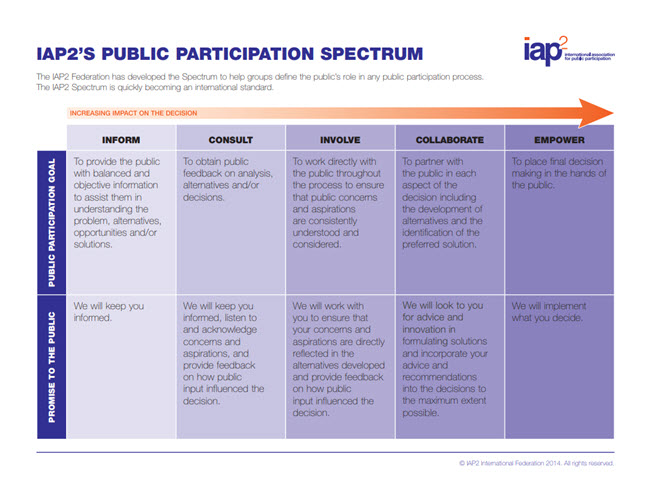Just how involved should the public be in decisions like where to put a 100Kv electric transmission line, or an incinerator, or a hazardous waste storage facility? Professional planners and others have thought about this question for a long time.
A milestone in this vein of planning scholarship was Sherry Arnstein’s article "A Ladder of Citizen Participation." In it, she describes eight “rungs” or levels of participation, from “nonparticipation” at the lowest rung to “citizen control” at the top. (The full citation of the original published article is: Arnstein, Sherry R. [1969]. A Ladder of Citizen Participation. Journal of the American Institute of Planners, 35[4], 216-224.)
Reading assignment
Numerous authors have reconsidered and refined Arnstein’s idea. Today the definitive treatment may be the “Spectrum of Public Participation” (pictured below) published by the International Association for Public Participation. Read the Spectrum carefully. (It’s just one page.) At the end of the lesson, you’ll be expected to use the Spectrum to evaluate the level of public participation in the case study presented in Lesson 1. Then you’ll use the Spectrum again in Lesson 10.

Click here to see a text description.
The IAP2 Federation has developed the Spectrum to help groups define the public's role in any public participation process. The IAP2 Spectrum is quickly becoming an international standard. The table below moves from less impact on the decision in the first column to most impact in the last column.
| -- | Inform | Consult | Involve | Collaborate | Empower |
|---|---|---|---|---|---|
| Public Participation Goal | To provide the public with balanced and objective information to assist them in understanding the problem, alternatives, opportunities and/or solutions. | To obtain public feedback on analysis, alternatives and/or decisions. |
To work directly with the public throughout the process to ensure that public concerns and aspirations are consistently understood and considered. |
To partner with the public in each aspect of the decision including the development of alternatives and the identification of the preferred solution. | To place final decision making in the hands of the public. |
| Promise to the Public | We will keep you informed. | We will keep you informed, listen to and acknowledge concerns and aspirations, and provide feedback on how public input influenced the decision. | We will work with you to ensure that your concerns and aspirations are directly reflected in the alternatives developed and provide feedback on how public input influenced the decision. | We will look to you for advice and innovation in formulating solutions and incorporate your advice and recommendations into the decisions to the maximum extent possible. | We will implement what you decide. |
